Biology Past questions for WAEC will help the science students as it is a compulsory subject for all of them and that is why we have decided to bring it here fir you to make thing easy for you.
You don’t have to worry going to search for Past questions to help you study because in this post, we are going to give you the complete 50 objectives Questions that WAEC will possibly set.
Biology Past Questions For WAEC
Below are all the biology past questions for WAEC, study and prepare well;
- A. parasitic
- B. holozoic
- C. saprophytic
- D. symbiotic
- A. diuresis
- B. plasmolysis
- C. endosmosis
- D. homeostasis
- A. saprophytes
- B. autotrophs
- C. parasites
- D. heterotrophs
- A. Contour ploughing
- B. establishment of game reserves
- C. deforestation
- D. afforestation
- A. protein
- B. amino acid
- C. fat
- D. glucose
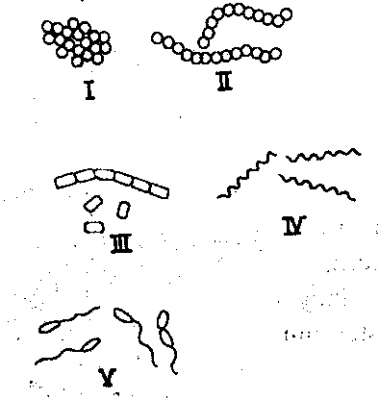
6. The diagrams above are illustrations of forms in which a particular group of organisms exist. Study them and answer the question.
Which group of organisms is illustrated?
- A. protozoa
- B. viruses
- C. fungi
- D. bacteria

7. The diagrams above are illustrations of forms in which a particular group of organisms exist. Study them and answer the question.
in which of the illustrated forms does the organism that causes cholera exist?
- A. III
- B. II
- C. IV
- D. V
- A. plants is indefinite
- B. plants is intercalary
- C. animals is apical
- D. plants is from within
- A. oesophagus
- B. epiglottis
- C. oesophagus
- D. liver

10. The diagram above is an illustration of a mango leaf drawn by a student in a Biology test. The student failed the test. Study it and answer the question.
The likely reason why the student failed the test was that the
- A. labels were wrong and the guidelines were not touching the structures
- B. net venation shown were few, rough, not properly drawn and wrongly placed
- C. leaf venation should have been parallel and the midrib should be thicker
- D. leaf was too tapered at the apex, the leaf stalk was too short and the shape of leaf was wrong.
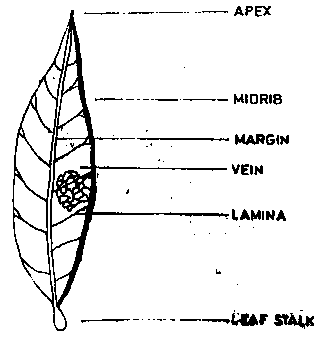
11. The diagram above is an illustration of a mango leaf drawn by a student in a Biology test. The student failed the test. Study it and answer the question.
which features of the diagram would have earned the student more marks if shown
- A. colour and size
- B. spelling of label and length of midrib
- C. habitat and agricultural qualities of leaf
- D. title and margin
- A. community
- B. biosphere
- C. niche
- D. population
- A. sucking
- B. chewing
- C. grinding
- D. absorption
- A. 3434
- B. 1212
- C. 1
- D. 1414
- A. earlobe
- B. gallbladder
- C. tailbone
- D. villus
- A. microscope
- B. Wind vane
- C. thermometer
- D. hygrometer
- A. Conservation of excess water
- B. competition for sunlight
- C. lack of adequate water
- D. formation of poor roots
- A. the foetus is deprived of nourishment
- B. they have poor circulatory system
- C. the blood of the foetus might clump
- D. the woman is susceptible to diseases during pregnancy
- A. oestrogen and ovary
- B. Oxytocin and hypothalamus
- C. adrenalin and kidney
- D. insulin and pancreas
- A. of consistent cool temperature
- B. of availability of moisture
- C. of the relatively constant daylight.
- D. there are more plants
- A. Goat
- B. maize
- C. man
- D. bacterium

22. The diagrams below are illustrations of organisms in a habitat. Study them and answer the question,
The feeding relationship between the organisms labelled III and IV in the diagrams is
- A. predation
- B. mutualism
- C. parasitism
- D. saprophytism
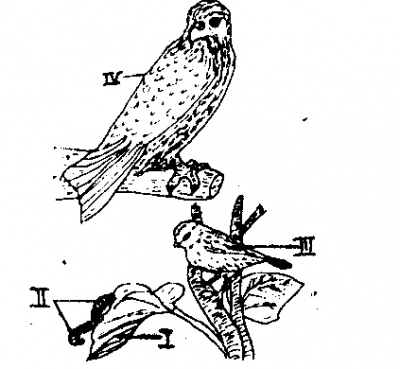
23. The diagrams below are illustrations of organisms in a habitat. Study them and answer the question, the producer in the diagram is
- A. IV because it is the largest organism in the diagram
- B. IV because it is the organism that receives the highest amount of sunlight
- C. I because it uses sunlight to manufacture food
- D. I because it contains the least amount of energy
- A. Sand and clay
- B. loam and sand
- C. silt and sand
- D. silt and clay

25. The diagram above is an illustration of a structure in the skeletal system of humans. Study it and answer the question
the illustrated structure is a part of the
- A. appendicular skeleton
- B. axial skeleton
- C. axis vertebrae
- D. cervical vertebrae
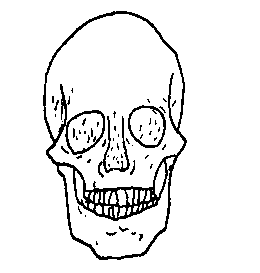
26. The diagram above is an illustration of a structure in the skeletal system of humans. Study it and answer the question
An individual was involved in a car accident and the illustrated structure was badly injured. Which of the following structures would most likely be affected?
- A. Clavicle, tongue and pelvis
- B. Eye, cerebellum and ear
- C. Ear, brain and hinge joint
- D. Lumbar, eye and teeth
I-Hydra
II-Owl
III-Snake
IV-Snail
The arrangement of the organisms in order of increasing complexity is
- A. II-III-I-IV
- B. I-IV-III – II
- C. I-II-III-IV
- D. IV-III-II – I.
I-Hydra
II-Owl
III-Snake
IV-Snail
The Phylum of the organism labeled IV is
- A. Platyhelminthes
- B. mollusca
- C. Arthropoda
- D. Coelenterata
- A. arrangement of ovules in the ovary of a flower
- B. part of the ovary where the ovules originate and remain till maturity
- C. ovules borne on a central column of tissues in an ovary
- D. formation of a single carpel joined at the two edges of an ovule
- A. Colour of flower
- B. Leaf size
- C. Height of plant
- D. fruit size
- A. movement of water from root hairs into cortical cell
- B. reabsorption of food nutrients from the kidney into blood capillaries
- C. translocation of starch from leaves to all parts of a plant
- D. movement of digested food from ileum into blood capillaries
- A. nitrogen
- B. iron
- C. sulphur
- D. magnesium
- A. myopia
- B. presbyopia
- C. astigmatism
- D. hypermetropia
- A. Energy from sunlight is absorbed
- B. Carbon (IV) oxide is evolved
- C. oxygen is evolved
- D. water is split

35. The illustration above is a genetic diagram. Study it and answer the question below.
What is the name of the genetic diagram?
- A. Genetic square
- B. Inheritance diagram
- C. Punnett square
- D. Genetic cross

36. The illustration above is a genetic diagram. Study it and answer the question below
What do the labels I, II, III, and IV respectively represent?
- A. Ee, Ee, EE and E
- B. EE, EE, Ee, and Ee
- C. EE, EE, EE and EE
- D. EE, EE, Ee and ee

37. The illustration above is a genetic diagram. Study it and answer the question
- A. 1:1
- B. 4:0
- C. 1:3
- D. 1:2:1
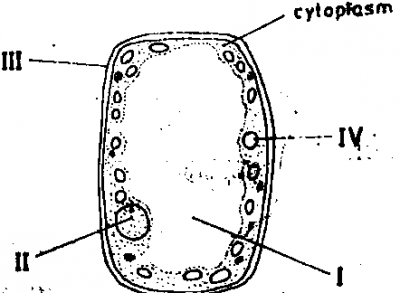
38. The diagram above is an illustration of a cell in which photosynthesis takes place. Study it and answer the question
In which of the labeled parts would molecules of water and carbon (IV) oxide combine to form sugar?
- A. I
- B. III
- C. II
- D. IV

39. The diagram above is an illustration of a cell in which photosynthesis takes place. Study it and answer the question. the oxygen gas formed in the cell diffuses out of the cytoplasm into the air spaces through the part labeled
- A. I
- B. II
- C. III
- D. IV
- A. streamlined body
- B. scales
- C. paired fins
- D. gills
- A. right auricle and right ventricle.
- B. aorta and the left ventricle
- C. left auricle and left ventricle
- D. right auricle and the superior vena cava
- A. stamens
- B. sperms
- C. ovules
- D. filament
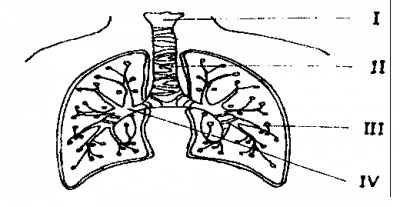
43. The diagram above is an illustration of some structures used for gaseous exchange in humans. Study it and answer the question
The parts labeled 1, II, III, and IV respectively are
- A. larynx, bronchus, bronchiole and trachea.
- B. bronchus, bronchiole, trachea and larynx.
- C. bronchiole, trachea, bronchus and larynx.
- D. larynx, trachea, bronchiole, and bronchus.
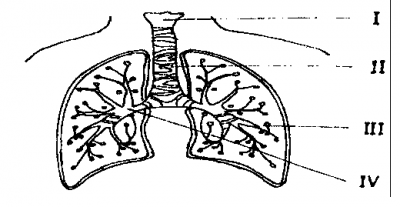
44. The diagram above is an illustration of some structures used for gaseous exchange in humans. Study it and answer the question
the part labeled III can be found in the
- A. lung
- B. heart
- C. kidney
- D. sternum
I – making shoes from crocodile skin
II – making tables with plastic
III – using elephant tusk for decoration
IV – using firewood for cooking
The act that should be encouraged for the conservation of wildlife and forests is
- A. III
- B. IV
- C. II
- D. I
I – making shoes from crocodile skin
II – making tables with plastic
III – using elephant tusk for decoration
IV – using firewood for cooking
In order to avoid some of the acts that would have negative effects on conservation. Government should
- A. encourage over-utilization of forest resources
- B. enact and enforce laws towards conservation of resources
- C. encourage indiscriminate killing of wildlife
- D. promote felling of trees without planting new ones
- A. nuptial flight
- B. searching for food
- C. communication
- D. pollination
- A. heterotrophic
- B. saprophytic
- C. chemosynthetic
- D. autotrophic
- A. fingerprinting
- B. tongue rolling
- C. DNA test
- D. blood group
- A. mutation
- B. linkage
- C. variation
- D. epistasis
Frequently Asked Questions
What should I read in biology for WAEC?
It is very much advisable to read all the topics you have been thought in biology as every topic will produce one or two questions
What is the hardest question in biology?
What is a DNA cell has to be one of the hardest questions WAEC do ask.
Conclusion
With the help of this past questions, you should be able to prepare easier and better and pay very much attention to them as WAEC might repeat this questions in the main exam. Good Luck